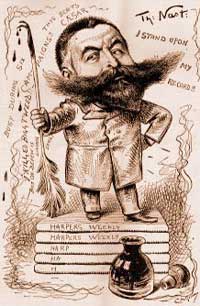Why Were Political Machines Bad

38d. Corruption Runs Wild

Harper's Weekly Mag
Thomas Nast was a cartoonist for Harper's Weekly Magazine. His cartoons condemning the decadent regime of Boss Tweed helped cease the era of car politics at Tammany Hall.
Becoming mayor of a big city in the Aureate Historic period was like walking into a cyclone. Demands swirled effectually metropolis leaders. Better sewers, cleaner h2o, new bridges, more efficient transit, improved schools, and suitable aid to the sick and needy were some of the more common demands coming from a wide range of interest groups.
To cope with the city's problems, regime officials had a limited resources and personnel. Democracy did not flourish in this surroundings. To bring guild out of the chaos of the nation's cities, many political bosses emerged who did not compress from corrupt deals if they could increase their ability bases. The people and institutions the bosses controlled were called the political machine.
The Political Machine
Personal politics can at once seem uncomplicated and complex. To maintain power, a dominate had to go on his constituents happy. Most political bosses appealed to the newest, most desperate part of the growing populace — the immigrants. Occasionally bosses would provide relief kitchens to receive votes. Individuals who were leaders in local neighborhoods were sometimes rewarded city jobs in return for the loyalty of their constituents.
Bosses knew they also had to placate large business, and did and so by rewarding them with lucrative contracts for construction of factories or public works. These industries would then pump big sums into keeping the political machine in office. Information technology seemed simple: "You scratch my back and I'll scratch yours." All the same, bringing diverse interests together in a city every bit large as New York, Philadelphia, or Chicago required hours of legwork and cracking political skill.
All the activities mentioned so far seem at to the lowest degree semi-legitimate. The problem was that many political machines broke their ain laws to suit their purposes. As contracts were awarded to legal business concern entities, they were as well awarded to illegal gambling and prostitution rings. Often profits from these unlawful enterprises lined the pockets of city officials. Public tax money and bribes from the business sector increased the bank accounts of these decadent leaders.
Voter fraud was widespread. Political bosses arranged to take voter lists expanded to include many phony names. In one district a four-year-sometime child was registered to vote. In another, a dog'south name appeared on the polling lists. Members of the automobile would "vote early and often," traveling from polling place to polling place to identify illegal votes. Ane commune in New York one fourth dimension reported more votes than information technology had residents.
Boss Tweed
The most notorious political dominate of the age was William "Boss" Tweed of New York'due south Tammany Hall. For twelve years, Tweed ruled New York. He gave generously to the poor and authorized the handouts of Christmas turkeys and winter coal to prospective supporters. In the process he fleeced the public out of millions of taxpayer money, which went into the coffers of Tweed and his assembly.
Attention was brought to Tweed'south corruption by political cartoonist Thomas Nast. Nast's pictures were worth more than than words every bit many illiterate and semi-literate New Yorkers were exposed to Tweed's graft. A zealous attorney named Samuel Tilden convicted Tweed and his rule came to an end in 1876. Mysteriously, Tweed escaped from prison and traveled to Spain, where he was spotted by someone who recognized his face up from Nast's cartoons. He died in prison in 1878.
Why Were Political Machines Bad,
Source: https://www.ushistory.org/us/38d.asp
Posted by: graingermisiongs.blogspot.com


0 Response to "Why Were Political Machines Bad"
Post a Comment